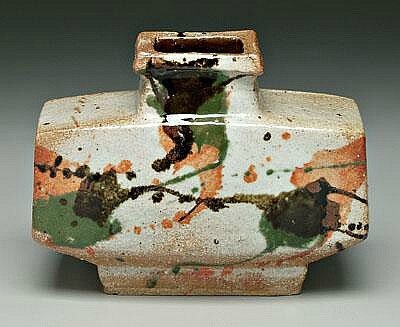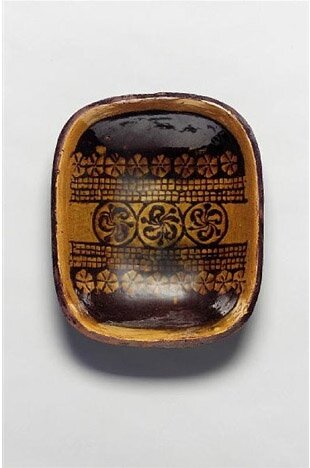Kawai Kanjirō 河井 寛次郎
Kawai Kanjirō (河井 寛次郎?, 24 August 1890 - 18 November 1966) was a Japanese potter and a key figure in mingei (Japanese folk art) and studio pottery movements, which included Bernard Leach, Shōji Hamada, Kenkichi Tomimoto, Shikō Munakata, Keisuke Serizawa, and Tatsuzō Shimaoka, among others.
Kawai was trained in the use of chemical glazes and gained wide recognition for their use while still in his early twenties. But he was ultimately dissatisfied with this early work and, thanks in large part to a chance encounter withYanagi Soetsu and Hamada Shoji, turned instead to natural glazes, to nature, or "to the science that precedes all science - and a return to nature was my salvation". He is widely regarded as a master of glazes, especially of warm red copper (shinsha or yuriko - one of his trademark colors), rich brown iron (tetsu-yu), chrome and cobalt (gosu).
As a potter he sought to combine modern methods of manufacture with traditional Japanese and English designs. He was also an artist, calligrapher, sculptor, writer and philosopher. As a man who respected the dignity of simplicity and collected the works of poor craftspeople from all over Asia, he admired "ordered poverty" and had a profound love for the unpretentious men of the soil and made their simplicity a part of himself. His pots come in many asymmetrical shapes and show expressionistic techniques such as tsutsugaki (slip-trailed decoration), ronuki (wax-resist) or hakeme (white slip).
Kanjirō refused all official honours, including the designation of Living National Treasure, and his pots were unsigned. His pieces are on display in the Folk Art Museum of Tokyo and each year, the Takashimaya Department Store had an exhibition of his work in their Tokyo and Osaka shops. In November 1953, Kawai-san had one of his biggest exhibitions. It was at the Korin Kaku in Tokyo and over 500 of his pieces were shown.
from Wikipedia






/https%3A%2F%2Fs-media-cache-ak0.pinimg.com%2F736x%2F9a%2Fe9%2Ff8%2F9ae9f8958d0355c33a8445be127e7689.jpg)
/http%3A%2F%2Fwww.felding.net%2Fimage%2Fpic%2Fclaymodelingtools%2F02claytools.jpg)
/https%3A%2F%2Fassets.over-blog.com%2Ft%2Fcedistic%2Fcamera.png)